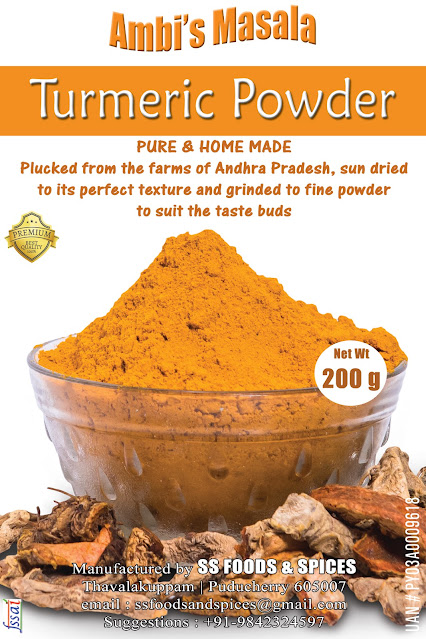Turmeric (Curcuma longa L), the ancient and sacred spice of India known as ‘Indian saffron’ is an important commercial spice crop grown in India. It is used in diversified forms as a condiment, flavouring and colouring agent and as a principal ingredient in Indian culinary as curry powder. It has anti cancer and anti viral activities and hence finds use in the drug industry and cosmetic industry. 'Kum-kum', popular with every house wife, is also a by-product of turmeric. It finds a place in offerings on religious and ceremonial occasions. A type of starch is also being extracted from a particular type of turmeric.
Turmeric is the dried rhizome of Curcuma longa L., a herbaceous perennial belonging to the family Zingiberaceae and a native of South Asia particularly India. The plant is propagated from rhizomes. The leaves are long, broad, lanceolate and bright green. The flowers are pale yellow and borne on dense spikes. The pseudostems are shorter than leaves. The rhizomes are ready for harvesting in about 7 to 9 months after planting.
Organic farming is a crop production method which encourages sustainable agriculture by enhancing the biological cycles in nature. It is targeted at producing healthy, nutritive, pollution free food maximising the use of on farm resources and minimising the use of off-farm resources. It seeks to avoid the use of chemical nutrients and pesticides.
Varieties :
1. More than 5 per cent curcumin content and lemon yellow, orange or orange yellow coloured turmeric powder are preferred in the international market. The orange-yellow flesh Alleppey turmeric is predominantly imported by the United States, where users prefer it as a spice and a food colorant.
2. The Madras turmeric is preferred by the British and Middle Eastern markets for its more intense, brighter and lighter yellow color.
3. 'Lokhandi' has bright coloured hard rhizomes and the other has light-coloured soft rhizomes which are cultivated in Sanghli, Maharashtra.
4. The popular commercial varieties in Andhra Pradesh are 'Duggirala' of Guntur and 'Tekurpeta' which has long, stout, smooth and hard fingers. 'Kasturi Pasupa' of the Godavari Delta, the 'Armoor' type of the Nizamabad area and the 'Chaya Pasupa' are the other important varieties of Andhra Pradesh.
The 9 (Nine) Scientific Health Benefits of Turmeric :-
1. Curcumin is an anti-inflammatory.
2. Curcumin may protect against Heart diseases.
3. Curcumin would prevent and help treating of Cancer.
4. Curcumin would help ease symptoms of Osteo-arthritis.
5. Would help in prevention of Diabetes due to Tetrahydro-curcumin.
6. Would help in delay or reverse Alzheimer's Disease.
7. Would help in treating Depression.
8. Would help in improving Skin Health.
9. Works as an anti-aging supplement & protects body from radicals.
